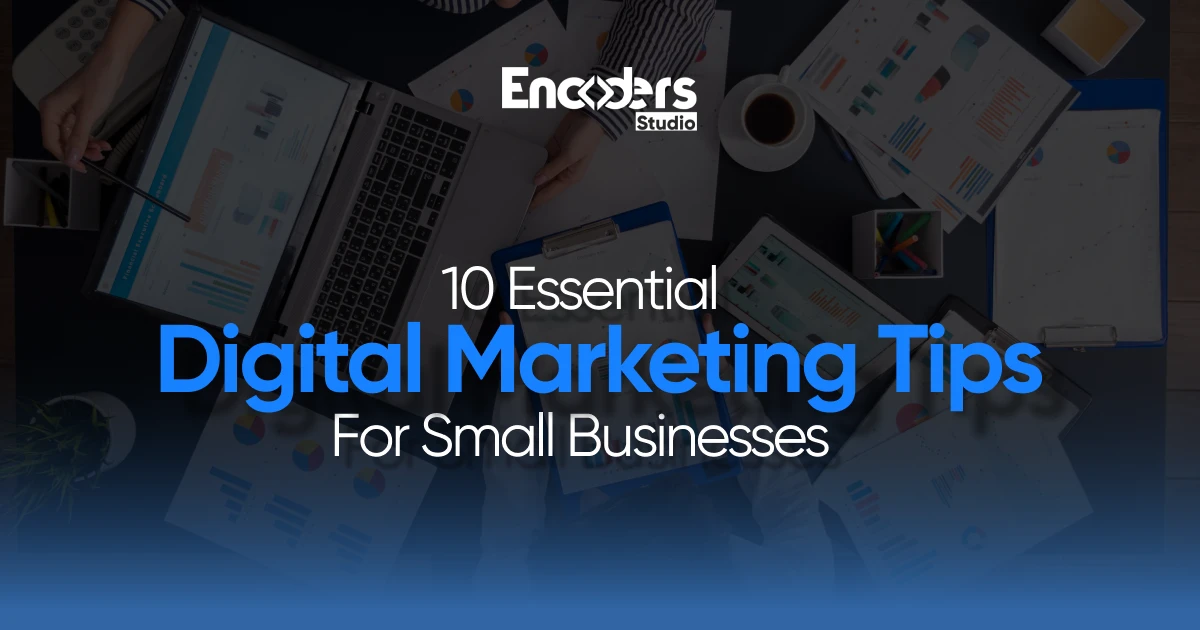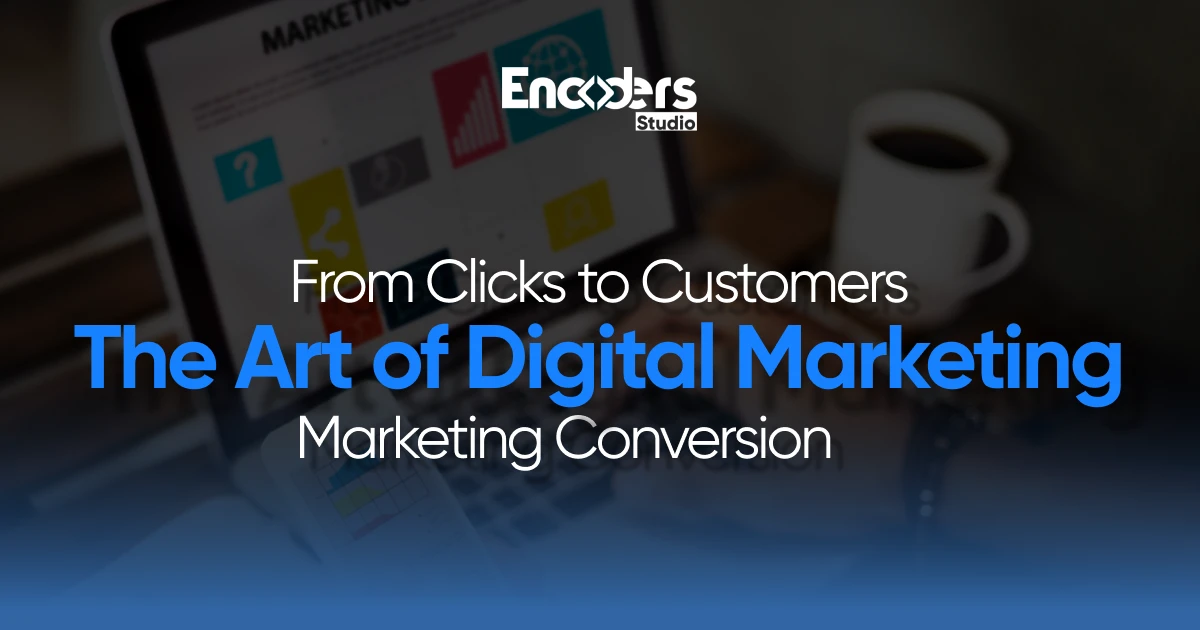[TL;DR]
Small businesses can grow fast in 2025 with the right digital strategy. Focus on knowing your audience, improving your SEO, and creating content that solves real problems. Use social media wisely, send personalized emails, and run targeted ads. Add videos, collect reviews, and automate where you can. Most importantly, track your results and continue to improve with Encoders Studio.
_________________________________________________________________________
Struggling to compete with big brands while managing tight budgets? We understand the frustration and desire. Most small business owners feel overwhelmed by the endless digital marketing options available today.
97% of consumers search for local businesses online, yet 46% of small businesses still don’t have a website. That’s millions of potential customers walking straight to your competitors.
Digital marketing for small businesses isn’t just about having a website anymore. It’s about creating a comprehensive online presence that turns visitors into loyal customers. The good news? You don’t need a Fortune 500 budget to succeed. Digital marketing levels the playing field by allowing small businesses to reach targeted audiences precisely when they’re ready to buy. Unlike traditional advertising, digital strategies provide measurable results and cost-effective marketing solutions for small businesses.
Your brand has a story, and it deserves to be told right. Encoders Studio digital marketing company, helps you shape that narrative through clean design, thoughtful content, and smart digital tools. Skip the generic and build something that feels true to you.
1. Understand Your Target Audience
Some businesses seem to effortlessly attract perfect customers while others struggle with unqualified leads. The difference? They understand exactly who they’re trying to reach. Successful digital marketing for small businesses starts with knowing your audience better than they know themselves. Start with research and create detailed buyer personas. This lays the foundation for everything from content creation to web development services customized to user needs.
Define Your Niche
Your niche is the specific segment of customers you serve better than anyone else. Instead of trying to appeal to everyone, focus on a specific group with particular needs.
Start by asking these questions:
- What problem does your product or service solve?
- Who experiences this problem most frequently?
- What makes your solution different from competitors?
📑 Pro-Tip: The riches are in the niches. Businesses that target specific audiences see 3x higher conversion rates than those targeting broad markets.
Create Buyer Personas
A buyer persona is a detailed profile of your ideal customer based on real data and research. This includes demographics, behaviors, motivations, and pain points. Create personas by:
- Surveying existing customers
- Analyzing website analytics
- Studying social media followers
- Interviewing sales team members
Your personas should include age, income, challenges, preferred communication channels, and buying behaviors.
2. Optimize Your Website for Search (SEO)
Search engine optimization ensures your website appears when potential customers are actively looking for solutions you provide. Local small business internet marketing success depends heavily on strong SEO foundations that help you outrank competitors.
Conduct Keyword Research
Keyword research reveals the exact phrases people type into search engines when looking for businesses like yours.
Use these keyword research steps:
- Start with basic terms related to your business
- Use tools like Google Keyword Planner or Ubersuggest
- Focus on long-tail keywords (3-4 words)
- Check what competitors are ranking for
💡 Mind-Blowing Fact: Google processes 8.5 billion searches daily. Missing SEO services means missing billions of potential customers, with 75% of users never scrolling past the first page.
Improve Site Speed and Mobile Friendliness
Your website must load quickly and work perfectly on mobile devices. Site speed directly impacts search rankings and user experience.
Optimize your site by:
- Compressing images
- Minimizing code
- Using reliable hosting
- Ensuring mobile responsiveness
📉 Business Reality Check: 53% of mobile users abandon sites that take longer than 3 seconds to load. That’s potential revenue walking away every second
Local SEO Tactics
Local small business internet marketing starts with optimizing for local searches. When people search for “pizza near me” or “plumber in [city],” you want to appear first.
Essential local SEO services tactics include:
- Creating a Google My Business profile
- Getting positive customer reviews
- Adding location-specific keywords
- Building local citations
Need a site that works as good as it looks? Or an app that doesn’t crash when it matters most? As the best social media marketing agency, we fuse creativity with technical precision to build digital products that perform under pressure.
3. Do Content Marketing
Quality content that educates, entertains, and solves problems separates businesses that attract customers naturally from those that struggle for attention. Content marketing builds trust and positions your business as the go-to expert in your field.
Blog Regularly on Relevant Topics
Regular blogging establishes your expertise while attracting potential customers.
Choose blog topics that:
- Answer common customer questions
- Solve specific problems
- Showcase your expertise
- Include relevant keywords naturally
📊 Content Marketing Insight: Companies that blog regularly generate 67% more leads than those that don’t. Content marketing costs 62% less than traditional marketing while generating 3x more leads.
Use Visuals (Images & Videos)
Visual content gets 94% more views than text-only content. Images and videos make your content more engaging and shareable. Effective visual strategies include:
- Using high-quality product images
- Creating infographics
- Adding videos to blog posts
- Designing branded graphics
Provide Value with How-To Guides
How-to guides position you as an expert while helping potential customers. These comprehensive resources often rank well in search results and get shared frequently. Create guides that:
- Solve real customer problems
- Include step-by-step instructions
- Use screenshots or videos
- End with a subtle call-to-action
4. Make the Most of Social Media Platforms
Social media platforms offer direct access to your target audience, but success requires a strategic approach rather than random posting. Smart social media strategy amplifies your brand voice and builds genuine connections with potential customers.
Choose the Right Networks for Your Audience
Focus your efforts on platforms where your target audience spends time.
Platform selection guide:
- Facebook: Great for local businesses and older demographics
- Instagram: Perfect for visual products and younger audiences
- LinkedIn: Essential for B2B companies
- TikTok: Excellent for reaching Gen Z consumers
🤔 Did you know? The average person uses 6.83 social media platforms, but businesses see better results focusing on 2-3 platforms consistently.
Engage Consistently and Authentically
Social media success comes from consistent, authentic engagement. Post regularly and respond to comments promptly. Engagement strategies include:
- Sharing behind-the-scenes content
- Responding to all comments and messages
- Asking questions to encourage interaction
- Sharing user-generated content
Use Stories, Reels, and Live Sessions
Short-form video content gets the highest engagement rates across all platforms. Stories and reels help you stay visible in algorithms.
🕵️♂️ Secret Tip: Posts with video content get 48% more views than image posts. Start with simple product demos or behind-the-scenes clips.
5. Utilize Email Marketing
Email marketing consistently outperforms all other digital channels, providing direct communication with interested prospects and existing customers. Affordable digital marketing doesn’t get better than email’s proven results and incredible return on investment.
Grow an Email List
Building a quality email list of interested prospects should be a top priority. List building tactics:
- Offer valuable lead magnets
- Add signup forms to your website
- Create exclusive content for subscribers
- Use exit-intent popups
Personalize and Segment Emails
Generic emails get ignored. Personalized emails based on customer behavior and preferences see much higher open and click rates. Segmentation strategies:
- Group by purchase history
- Segment by location
- Divide by engagement level
- Separate by customer lifecycle stage
Send Regular, Value-Driven Newsletters
Consistent communication keeps your business top of mind. Send newsletters that provide value, not just sales pitches. Newsletter content ideas:
- Industry tips and insights
- Customer success stories
- New product announcements
- Educational content
6. Run Targeted Online Ads
Targeted online advertising levels the playing field by allowing precise audience targeting with controlled budgets. When managed properly, paid ads deliver immediate visibility and measurable results that help small businesses compete effectively.
Use PPC (Google Ads, Bing Ads) for Immediate Leads
Pay-per-click advertising delivers immediate visibility and leads. PPC best practices:
- Start with exact match keywords
- Write compelling ad copy
- Use negative keywords
- Create dedicated landing pages
Run Targeted Social Media Campaigns
Social media advertising allows precise targeting based on demographics, interests, and behaviors. Affordable digital marketing becomes possible with smart targeting. Targeting options include:
- Age and location
- Interests and hobbies
- Shopping behaviors
- Connection to your page
Set Clear Budgets and Track ROI
Every advertising dollar must be tracked and measured. Set daily budgets and monitor return on investment closely. Key metrics to track in PPC services in Pakistan:
- Cost per click (CPC)
- Click-through rate (CTR)
- Conversion rate
- Return on ad spend (ROAS)
7. Embrace Video Marketing
Video content captures attention and drives engagement like no other format available today. Modern consumers prefer watching over reading, making video essential for cost-effective marketing solutions for small businesses looking to maximize their reach.
Short-Form Video (Reels, TikTok)
Short-form videos dominate social media algorithms. Short-form videos have 2.5x higher engagement rates than longer videos. The average attention span for video content is just 8 seconds. Video content ideas:
- Quick product demonstrations
- Behind-the-scenes glimpses
- Customer testimonials
- Industry tips and tricks
Product Demos and Testimonials
Video testimonials build trust more effectively than written reviews. Product demos help customers understand your offerings clearly. Effective video strategies:
- Keep demonstrations under 2 minutes
- Focus on benefits, not just features
- Include real customer stories
- Add captions for accessibility
Live Q&A Sessions
Live video creates authentic connections with your audience. Regular Q&A sessions position you as an expert while building community. Live session tips:
- Announce sessions in advance
- Prepare common questions
- Encourage audience participation
- Save recordings for later use
8. Build Trust with Real Stories and Social Proof
Trust and credibility often determine the final purchasing decision when customers are comparing similar businesses. Social proof through reviews, testimonials, and authentic stories builds the confidence customers need to choose your business over competitors.
Showcase Customer Reviews and Testimonials
Customer reviews influence 93% of purchasing decisions. 88% of consumers trust online reviews as much as personal recommendations. One negative review can cost you up to 30 customers. Review strategies:
- Ask satisfied customers for reviews
- Respond to all reviews professionally
- Display testimonials prominently
- Use video testimonials when possible
Collaborate with Micro-Influencers
Micro-influencers (1,000-100,000 followers) often deliver better results than mega-influencers. They have higher engagement rates and more authentic connections. Collaboration benefits:
- Higher engagement rates
- More affordable partnerships
- Better audience alignment
- Authentic recommendations
9. Use Digital Tools & Automation
Smart automation handles repetitive tasks while ensuring consistent customer communication. The right tools free up time for strategy and creativity while maintaining professional standards that keep your business running smoothly.
Schedule Posts and Emails
Consistency matters more than perfection in digital marketing. Useful automation tools:
- Social media scheduling platforms
- Email marketing automation
- Customer relationship management (CRM) systems
- Analytics dashboards
Automate Customer Responses and Reminders
Automated responses ensure customers get immediate acknowledgment. Set up systems for common inquiries and follow-ups. Automation opportunities:
- Welcome email sequences
- Appointment reminders
- Social media auto-responses
- Follow-up surveys
Use AI for Personalization
AI tools can personalize customer experiences at scale. Use artificial intelligence to deliver relevant content and recommendations.
AI applications include:
- Personalized product recommendations
- Dynamic email content
- Chatbot interactions
- Predictive analytics
10. Analyze, Test, and Adapt
Continuous improvement based on real data and testing results separates businesses that grow consistently from those that plateau. Cost-effective marketing solutions for small businesses require constant optimization to maximize every marketing dollar spent.
Track Key Metrics (Conversion, CAC, ROAS)
Tracking essential metrics helps you understand what’s working and what needs improvement. Essential metrics include:
- Conversion rates
- Customer acquisition cost (CAC)
- Return on ad spend (ROAS)
- Customer lifetime value (CLV)
A/B Test Campaigns
A/B testing reveals what resonates with your audience. Test different headlines, images, calls-to-action, and timing. Testing elements:
- Email subject lines
- Ad headlines and copy
- Landing page designs
- Call-to-action buttons
Adjust Strategies Based on Data
Use data insights to refine your approach continuously. Cost-effective marketing solutions for small businesses come from constant optimization. Optimization strategies:
- Review performance weekly
- Adjust budgets based on results
- Eliminate underperforming campaigns
- Double down on successful tactics
Your Way to Digital Marketing
These 10 digital marketing strategies provide a roadmap for small business success in 2025. Start with understanding your audience, optimizing your website for search, and gradually implementing additional tactics. Remember that consistency beats perfection. Focus on 2-3 strategies initially, master them, then expand your efforts. Track your results, test new approaches, and adapt to changing trends.
Want to dominate your local market?
Encoders Studio specializes in helping small businesses achieve remarkable digital growth. Our proven strategies have helped countless businesses increase website traffic by 50% and sales by 25% within just 3 months. As Pakistan’s top digital marketing agency, we understand the unique challenges small businesses face. Our team combines creative expertise with data-driven strategies to deliver measurable results that fit your budget.
FAQs
What are the most effective digital marketing strategies for small businesses in 2025?
The most effective strategies include local SEO, content marketing, social media engagement, email marketing, and targeted online ads. These are often enhanced with AI tools for better personalization.
How much should small businesses spend on digital marketing?
Small businesses typically allocate about 7–10% of their annual revenue to digital marketing. This helps them achieve sustainable growth and measurable results.
How can small businesses compete with larger companies using digital marketing?
Small businesses can compete by focusing on authentic storytelling and niche targeting. Personalized customer interactions and local SEO also help build strong community connections.
What common digital marketing mistakes should small businesses avoid?
Avoid spreading efforts too thin across platforms or neglecting mobile optimization. Don’t overlook SEO basics, and always set clear, measurable marketing goals.
How important is understanding your target audience in digital marketing?
Understanding your audience is critical. It helps you create targeted campaigns, personalize messages, and choose the right platforms for better engagement and ROI.
What key metrics should small businesses track to measure digital marketing success?
Important metrics include conversion rates, customer acquisition cost (CAC), and return on ad spend (ROAS). Also track email open rates, click-through rates, and social media engagement.




